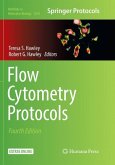Flow cytometry is a useful method for obtaining the phenotype and characteristics of cells. It is based on the scattering of light by the cells under test and the emission of fluorescence from them. Fluorescence emission is achieved either by the direct use of fluorescent dyes or a combination of fluorescent dyes and monoclonal antibodies. These fluorescence-conjugated antibodies can detect and bind to surface molecules or internal compounds of cells, making it possible to identify cell types in a diverse cell population by flow cytometry. This method was basically developed by immunologists who tried to sort pure populations of cells from each other and after proliferating them in cell culture medium to study the individual role of each cell in the immune system. Nowadays, the use of modern technologies to increase the speed of doing work and ease of doing them is expanding increasingly. Flow cytometry is commonly used to identify cell line, analyze mature cell tissue, and detect heterogeneity in tumor cell population. In the last decade, the use of this method in clinical laboratories and diagnosis of various types of cancer has increased dramatically.
Bitte wählen Sie Ihr Anliegen aus.
Rechnungen
Retourenschein anfordern
Bestellstatus
Storno









